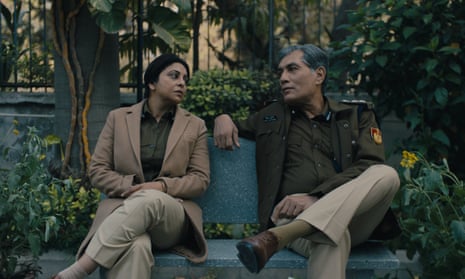This year’s Emmy awards, one of the biggest nights in global television, was particularly historic for India. It was the second year in a row that several Indian television shows were nominated, and the first time an Indian series won. Delhi Crime, an eight-part Netflix drama exploring a brutal rape case in 2012, took home the award for the best international series.
Indeed, all the Indian nominations were for shows created by Netflix or Amazon Prime. Over the past two years, streaming has radically shifted India’s domestic creative landscape – and created a new global audience for Indian series and films. According to Amazon Prime, 20% of viewers of their original Indian content are now from outside India.
“India is a land of storytellers but for a very long time, because of the formulaic nature of cinema and television, there was not representation of all kinds of stories,” said Aparna Purohit, head of original content at Amazon Prime India. “Streaming has democratised that. Stories that were not picked up earlier, subjects that were ignored or avoided, now there is a space for them.”
The two biggest streaming platforms, Netflix and Amazon Prime, arrived in India four years ago but it is only over the past two years that momentum has begun to build.
But as the platforms began to flourish, they have faced a growing backlash from hardline, rightwing groups in India, which have accused Netflix and Amazon of creating content that “hurts the fabric of Indian society”. While the platforms were previously free from the censorship that controls all film and television in India, enabling new, bolder programming, the government declared in November that all streaming platforms would be brought under regulation.
In a country of more than 1.3 billion people, half of whom are under the age of 25, Amazon and Netflix have made huge investments in harnessing lucrative potential. According to senior executives, India is now witnessing the biggest growth of any global streaming market.
In 2019-20, Netflix invested $400m (£293m) in creating original programmes and released more than 30 pieces of original Indian content. Amazon Prime now has customers in more than 4,300 towns and cities across India and has about 50 shows in varying stages of development. As well as shows in Hindi and English, both platforms are creating original content in regional languages including Tamil, Telugu and Malayalam.
“This year has been an incredible year for us in India because we are one of the fastest growing markets in all of global Netflix,” said Monika Shergill, vice-president of content at Netflix India. “We’ve got a huge new member base in India who we have found to be hungry for different stories and formats.”
Several Indian-made shows had made it into the Netflix Top 10 in countries around the world, with the reality show Fabulous Lives of Bollywood Wives and the children’s animation Mighty Little Bheem cited as recent global successes, said Shergill.

Although India has its thriving Bollywood and regional film industries and a culture of long-running television serials, there was no industry tradition of the immersive longform storytelling that streaming services are known for. Much of Netflix and Amazon’s early investment went into building up a new pool of talent.
“We had to build it, brick by brick,” said Purohit of Amazon Prime. “We invested very heavily in development, taking a long time to green-light projects. We started organising writers’ workshops where we would bring in new writers and veteran show-runners and creators. Just trial and error, working and learning along the way.” At the beginning, Bollywood’s big names were reluctant to collaborate, but now they were knocking on Amazon Prime’s door.
There have also been logistical challenges: 96% of Indian homes have a single TV, which is rarely a smart TV with internet access. But with the second-highest mobile phone ownership in the world and widespread access to cheap mobile data, most of India now watches video via phone. Netflix says its subscribers in India watch more on mobile than anywhere else in the world.
Growth has been helped by low subscriptions starting at 129 rupees (£1.30) a month for Amazon Prime and 199 rupees a month for Netflix, though with average monthly household incomes at 32,800 rupees (£328), it remains unaffordable for millions.
But the threat of future regulation hangs heavy. As government censorship keeps an increasingly tight rein on the cultural sphere, Amazon and Netflix have become a breeding ground for more subversive and groundbreaking shows such as Leila, Sacred Games and Paatal Lok, which have addressed sex, sexual violence, homophobia and caste inequalities, critiqued rightwing Hindu nationalism and depicted the persecution of Muslims. A new gritty political drama Tandav, described as India’s equivalent to House of Cards, will debut on Amazon Prime this month.
“This kind of programming could not be done in the past,” said Gaurav Gandhi, Director and Country GM of Amazon Prime Video India. “The world of streaming allows new freedom for the creators.”
The backlash against certain shows has been visceral, setting off online hate campaigns against stars and creators. Sacred Games, the big Netflix break-out series, was threatened with a court case for a line where the former prime minister Rajiv Gandhi is called fattu, translated as pussy.
Netflix, Amazon and 16 other streaming platforms in India have put together a code of self-regulation which they hope to persuade the government to adopt, rather than being forced to comply with the same censorship rules as Bollywood.
Shibasish Sarkar, group chief executive officer of Reliance Entertainment, one of the biggest production houses in India whose credits include Sacred Games, said: “In three years, the cultural side of India had achieved on streaming platforms what it would have taken 30 years to achieve in the traditional film and TV industries.
“Writers and makers have enjoyed [being] free to communicate with the audience [without] restrictions or regulators or censors. A structure of self-regulation and self-discipline is what we should be aiming for. Otherwise we will lose the mojo.”
